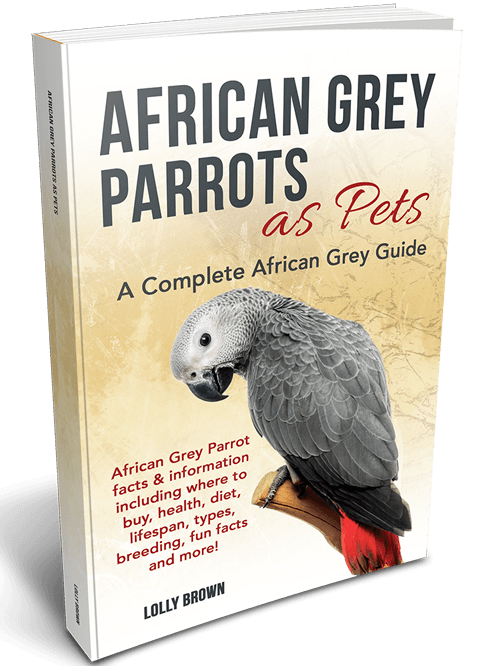CHAPTERS
Navigate to chapter
► Chapter 1: Introduction
► Chapter 2: African Grey in Focus
► Chapter 3: To Buy or Not to Buy?
► Chapter 4: Tips in Buying African Greys
► Chapter 5: Keeping African Grey Healthy.
► Chapter 6: African Grey Checklist
Chapter 2: African Grey in Focus

Before getting a pretty grey bird as your pet, it’s very important that you know what it is inside out!
Like many other things, you need to have proper knowledge and invest a significant amount of time to truly study and understand where these birds are coming from. That is how you will determine if this kind of pet is the right choice, so that you know what you are dealing with.
1.) What Are African Greys?
The African Grey Parrot, which is scientifically known as Psittacus Erithacus, is a vulnerable species of Psittacidae. It is a medium-sized parrot and its distinctive features are its gray feathers with white markings around the eyes and black bleak.
There are two accepted subspecies – Psittacus erithacus erithacus, sometimes known as the red-tailed Congo African grey parrot, and Psittacus erithacus timneh, also known as the Timneh African grey parrot. The former is larger in size than the Timneh. The latter is smaller with dark-gray feathers and a chestnut tail.
The African grey parrot feeds on a variety of fruits, seeds and nuts, particularly those of the oil-palm. These birds inhabit savannas, coastal mangroves, woodland and edges of forest clearings in their West and Central Africa range.
These species is much appreciated as a pet, due to its high intelligence, sociability, ability to learn and reproduce human speech and its magnificent beauty.
2.) Facts About African Greys

In terms of geographic range, the two known species have varying ranges. Congo African grey parrot inhabits a range extending from Kenya to the eastern border of the Ivory Coast while the Timneh African grey parrot has a range from eastern border of Ivory Coast to Guinea-Bissau. They make their nests in tree holes and makes seasonal movements out of the driest part of the region in the dry season.
These parrots typically measure 33 cm from head to tail and weigh up to 407 grams. They have an average wingspan of 46 – 52 cm.
In terms of reproduction, the breeding season varies by locality but appears to coincide with the dry season.
They breed once to twice a year. Breeding occurs in loose colonies with each pair occupying its own tree. Females lay three to five roundish eggs, one each at intervals of two to five days. Incubation takes about thirty days and the young emerge from the nest at approximately twelve weeks old. Both parents care for their clutch of young until they reach independence.
In the wild, their average lifespan is 23 years, but in captivity, they last for forty five years, and can live up to sixty years! Now that’s for keeps!
Wild African Grey parrots follow a daily pattern of vocalization; their impressive mimicry is also part of the fascinating facts about them, scientific studies have shown that they are able to make the connection mentally between words and their meanings, to express certain preferences and even to apply concepts such as color, shape and number.
These birds are mostly herbivores. Like what you have learned earlier in this book, they feed primarily on nuts and fruits such as oil- palm, and supplemented by leafy matter, as well as insects and flowers.
African Grey parrots are vulnerable to terrestrial predators which makes them a near threatened species. They are the most popular avian pet in United States, Europe and Middle East.
- : phylum Chordata, class Aves, order Psittaciformes, family Psittacidae, Genus Psittacus, Species Psittacus Erithacus
- : Kenya, Ivory Coast, Guinea-Bissau, Sierra Leone, Ghana
- : Tropical; Terrestrial
- :
- : 3 to 5 eggs per season
- : 30 days
- : 33 cm from head to tail
- : 407 grams
- : 46 – 52 cm
- : White face patches, Grey contour feathers, black beaks, red tails, silvery yellow eyes
- : Males are slightly longer than females; Females have a narrower head and a suppler neck.
- : nuts, fruits, seeds, insects, flowers
- : mimicry; choruses
- : 23 years in the wild; 45 to 60 years in captivity
3.) African Greys in History
In the early 1500’s it is said that King Henry VII of England had an African Grey parrot at Hampton Court. The wealthy nobility of Europe valued this pet for its attractiveness and intelligence.
According to Dr. W. T. Greene, one of the early authors of the 1800’s, he believed that the African Grey parrot was actually known to the ancient Hebrews some 4,000 years ago. In the early days, the Portuguese seafarers called Grey parrot “Jaco” because it is related to the sound of their natural cry.
In 1774, German naturalist, Johann Bechstein described an African Grey parrot owned by Cardinal Ascanius. The cardinal’s parrot was quite popular because it could recite the Apostle’s Creed in an articulate manner.
The oldest surviving example of African Grey bird taxidermy can be found in Westminster Abbey in London. It was owned by Frances Teresa Stuart, Duchess of Lennox.
The most recent and significant research done was back in the 1970’s by Dr. Irene Pepperberg of the Alex Foundation. She studied the intelligence and speaking ability of her African Grey parrot named Alex, who died in 1977.
4.) Types of African Grey Parrots

As you have already learned, there are two major types of African Grey Parrots. Take a closer look at this table and do a comparison to see which type you prefer.
Continue Reading…
Want to read the entire thing?


